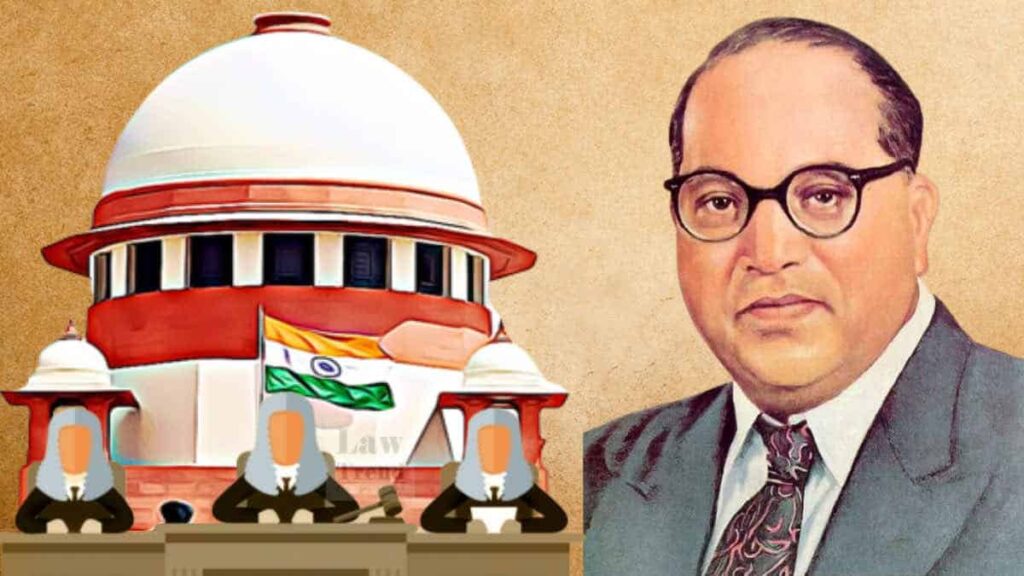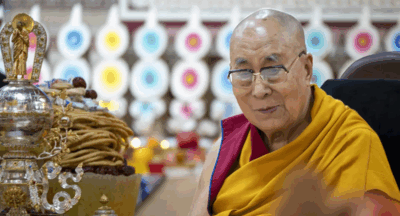By Sushovan Patnaik
Today, as we remember Babasaheb Ambedkar on his 135th birth anniversary, there is a certain crisis of identity that the Indian judiciary seems to be confronting. On this exact day, a month ago, members of the fire department allegedly discovered piles of burnt currency in the residence of a Delhi High Court judge. Since then, the executive has prominently reframed a conversation on judicial accountability towards that of judicial appointments.
Notably, a significant way in which public consensus has been sought to be established regarding rejecting the Collegium system to substitute with the NJAC, has been through the invocation of Dr Ambedkar.
This is not a new phenomenon and a lot of it has been rooted in the Collegium’s very substantial failure in building a representative judiciary. A portion of the Ambedkarite community has lent support to the idea of NJAC precisely due to this – the law ministry last month indicated that 78 percent judges appointed to High Courts were upper caste, and a report I had co-authored previously had found that 36.4 percent of the Indian Supreme Court, as of December 2023, was entirely Brahmin.
In this context, it seems Ambedkar has been strategically invoked to build a case for the NJAC, but it has been done through, what I consider to be, a misinterpretive reading of Babasaheb’s nuanced position on judicial appointments.
On March 27, attorney general K.K. Venugopal, while arguing for a reconsideration of the NJAC decision, suggested that in the Constituent Assembly, a proposal to replace “consultation” with “concurrence” in Article 124 of the Constitution, in terms of the Chief Justice of India’s role in appointments, was “swiftly rejected” by Dr Ambedkar. He goes on to quote Ambedkar’s address on May 24, 1949, where amendments were proposed to the provision by members such as K.T. Shah. Ambedkar had said:
“With regard to the question of the concurrence of the Chief Justice, it seems to me that those who advocate that proposition seem to rely implicitly both on the impartiality of the Chief Justice and the soundness of his judgment. I personally feel no doubt that the Chief Justice is a very eminent person. But after all the Chief Justice is a man with all the failings, all the sentiments and all the prejudices which we as common people have; and I think, to allow the Chief Justice practically a veto upon the appointment of judges is really to transfer the authority to the Chief Justice which we are not prepared to vest in the President or the Government of the day. I therefore think that is also a dangerous proposition.”
Venugopal is not the first to have used this quote by Ambedkar to argue that the Collegium’s formation in the Second judges’ case was a gross divergence from the intent of the Drafting Committee’s chairman. In a November 2022 op-ed, Dilip Mandal and Nitin Mehsram noted that “the idea that the CJI-led collegium has primacy because the word ‘consultation’ occurs in Article 124 and amounts to ‘concurrence’ and that the Collegium’s role is essential in making the judiciary independent is nothing but a rewriting of the Constitution and giving veto power to the CJI. It is the same idea that the Constituent Assembly expressly rejected by voice vote decades ago.”
While this conclusion itself is debatable, contextually this is an important argument to understand because Mandal has publicly expressed his support for an NJAC system, and seems to indicate that provision of any sort of primacy to the judiciary in appointments was opposed to Ambedkar’s interests.
The significant issue with invoking Dr Ambedkar to garner support for the NJAC is that the latter is grossly opposed to the ‘separation of powers’ and independence of the judiciary.
Notably, Ambedkar could not have been more resolute in his vision for judicial independence and separation of powers. He believed the judiciary to be the most crucial forum for exercise of rights and believed that its institutional independence was at the core of its ability to do so. In ‘States and Minorities’, he wrote, “It is no use giving rights if the aggrieved person has no legal remedy to which he can resort when his rights are invaded.” Thus, the draft Constitution aimed to “prevent the Legislature and the Executive from overriding” the rights. He noted that the provision for constitutional remedy through writs “proposes to give protection to the citizen against Executive tyranny by investing the Judiciary with certain powers of inquisition against the abuse of authority by the Executive.”
In ‘Lectures on the English Constitution’, Ambedkar criticised the political arrangement in the UK since the King was part of the legislature, the executive and was also the supreme executive authority. He wrote, “The Ministry which carries on the executive Government of the country in the name of the King are members of Parliament. There is, therefore, no separation between the executive and the legislature. The Lord Chancellor is the working head of the Judicature. He is also a member of the Cabinet. There is, therefore, no separation between the executive and the judiciary.”
In his May 1949 speech, shortly before he critiqued the proposal to allow final say to the Chief Justice, Ambedkar spoke in length as to why the conversation needed to be carefully framed without diluting separation of powers. He argued that “there can be no difference of opinion in the House that our judiciary must both be independent of the executive and must also be competent in itself … it would be dangerous to leave the appointments to be made by the President, without any kind of reservation or limitation, that is to say, merely on the advice of the executive of the day. Similarly, it seems to me that to make every appointment which the executive wishes to make subject to the concurrence of the Legislature is also not a very suitable provision. Apart from its being cumbrous, it also involves the possibility of the appointment being influenced by political pressure and political considerations”
Clearly, judicial independence was an uncompromisable principle in Ambedkar’s vision. Judicial independence was being hotly debated around that time. While both Nehru and Ambedkar espoused the separation of powers, they seemed to favour the suggestion of the Sapru Commission Report, brought out in 1945, which was the first to have recommended that judicial appointments be made by the President, in consultation with the Chief Justice. On the face of it, there was certain contradiction in what Ambedkar and Nehru were professing, and what they were favouring in practise since the Report clearly vouched to provide final say in appointments to the executive. And it was not a contradiction that was unnoticed: as historian Rohit De notes, judges across India’s High Courts wrote to the Constituent Assembly in great numbers. One concern raised was that executive supremacy in appointments might result in appointments becoming communally tinged – an argument that greatly annoyed Home Minister Vallabhbhai Patel. The first Chief Justice of India, H.J. Kania, was similarly upset with the executive being granted supremacy in appointments and wrote a letter to Nehru in 1947 stating that appointments must be “insulated” from executive and political influence. In 1948, in a meeting with Nehru, he flagged that in the High Court of East Punjab, there were accounts of political meddling in appointments.
Thus, the model of executive supremacy in appointments had flaws, and it is not a simple task to attempt to reconcile Ambedkar’s position on judicial independence with his stance on who must have the final say in judicial appointments during the final years of the Constitution’s framing. Notably also, it was a position that must be viewed specifically in the context of an emerging judiciary of that time, one that was still in the process of forming a coherent collective identity.
What is clear, however, is that Ambedkar’s extensive, principled articulation on the separation of powers, and its importance for the exercise of those enshrined rights which would effectuate justice for the ‘Depressed Classes’ makes one firmly believe that he would not have preferred a model such as NJAC. Even though the NJAC model promised the representation of at least one of the nominees from a Scheduled Caste, Scheduled Tribe, woman or minority community, the process of appointment of the nominees was critically opposed to judicial independence, and hence, contrasted to Ambedkar’s vision of why the judiciary might be the only institution capable of effectuating rights.
Anurag Bhaskar in ‘The Foresighted Ambedkar’ has argued that Ambedkar’s ultimate proposition for appointments was to go for a “deliberative process” and that the current Collegium system, enshrined after the Third judges’ case was more aligned with Ambedkar’s vision since “the process of appointment of judges became more consultative than it was before.” In the Fourth judges’ case, Justice J.S. Khehar, writing the majority opinion came to the same conclusion, noting that “Dr BR Ambedkar therefore, very clearly concluded the issue by expressing that it would be improper to leave the appointments of Judges to the Supreme Court, to be made by the President, on the aid and advice of the Council of Ministers, headed by the Prime Minister.”
The only issue with this conclusion is that the present Collegium arrangement is riddled with issues, as I have noted above, its failure to ensure representation being one of them. As Indira Jaising and I have argued, it certainly does appear that the Collegium is in a state of compromise – all signs indicate that the executive has exerted backdoor influence in appointments as well as transfers of judges. Moreover, the procedure surrounding judicial accountability requires a thorough review. Overall, a democratised, transparent procedure for appointments requires certain critical reforms in the Collegium.
The most encompassing conclusion that we could thus make is that while Ambedkar’s vision on appointments cannot be so obviously aligned with the Collegium’s functioning, it certainly seems to be more in line with demanding significant reforms to the Collegium than it would be to a model akin to the NJAC. As Ambedkar’s name continues to be invoked to support the NJAC, such a nuanced understanding of his thoughts, must bear heavily on our minds. (IPA Service)
Courtesy: The Leaflet


 Donald Trump-Barack Obama Spat On Harvard Funding Has Caught Global Attention
Donald Trump-Barack Obama Spat On Harvard Funding Has Caught Global Attention 